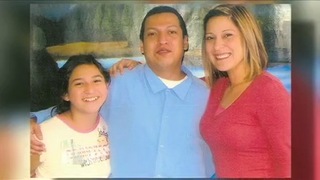
Related
Guests
- Anthony Gravesformer Texas death row prisoner who testified Tuesday at the first-ever congressional hearing on solitary confinement in U.S. prisons. Graves was fully exonerated in 2010 after spending 18 years behind bars, the bulk of that time on death row and in solitary confinement. He is now an active member of the movement to abolish the death penalty.
- James Ridgewayveteran journalist and co-editor of Solitary Watch, a website that tracks solitary confinement and torture in American prisons. He writes regularly for Mother Jones and is a 2012 Soros Justice Fellow, along with his reporting partner, Jean Casella.
In the first-ever hearing of its kind, a Senate panel heard testimony this week on the psychological and human rights implications of solitary confinement in U.S. prisons. While defenders of solitary confinement claim it is needed to control the most violent prisoners, many of the people called to testify at the hearing described how it can cause intense suffering and mental illness. We’re joined by Anthony Graves, a former Texas prisoner who was fully exonerated of a murder conviction after spending 18 years behind bars, the bulk of that time on death row and in solitary confinement, and by James Ridgeway, a veteran journalist and co-editor of Solitary Watch, a website that tracks solitary confinement and torture in American prisons. [includes rush transcript]
Transcript
JUAN GONZÁLEZ: We begin today’s show with a look at solitary confinement. On any given day, tens of thousands of prisoners in the United States are held in prolonged isolation for up to 23 hours a day. Many are kept in cells no larger than seven feet by 10 feet and have their only human contact when guards slide through meals in a slot in their cell door.
These conditions were the subject of a historic congressional hearing Tuesday called by Senator Dick Durbin, Democrat of Illinois and chair of the Senate Judiciary Subcommittee on the Constitution, Civil Rights and Human Rights. This is how Senator Durbin began the hearing.
SEN. DICK DURBIN: The United States holds far more prisoners in segregation or solitary confinement than any other democratic nation on earth. The Bureau of Justice Statistics found that, in 2005, U.S. prisons held 81,622 people in some type of restricted housing. In my home state of Illinois, 56 percent of the prison population has spent time in segregation.
If I had one request to my colleagues on this judiciary committee, it is to visit a prison. Do it frequently. See what it’s like. I’ve done it, most recently in Pekin at the federal facility. But I’ve been to Tamms, which is our maximum confinement facility in the state of Illinois. It is an eye opener to understand what it means when you start talking about the sentencing aspects of Americans’ criminal justice system.
We don’t always use solitary confinement at such a high rate, but in the 1980s, things started changing. We began creating expensive supermax prisons designed to hold people in isolation on a massive scale. These supermaxes, just like the crack cocaine sentencing laws, were part of a tough-on-crime policy that many of us thought made sense at the time. But we now know that solitary confinement isn’t just used for the worst of the worst. Instead, we’re seeing an alarming increase in isolation for those who don’t really need to be there, and for many, many vulnerable groups like immigrants, children, LGBT inmates, supposedly there for their own protection.
JUAN GONZÁLEZ: That was Senator Dick Durbin of Illinois. While defenders of solitary confinement claim it is needed to control the most violent prisoners, many of the people called to testify at the hearing described how it can cause intense suffering and mental illness. Among those who testified was former Texas death row prisoner, Anthony Graves.
ANTHONY GRAVES: Thank you, Mr. Chairman. My name is Anthony Graves, and I am death row exoneree number 138. I was wrongfully convicted and sentenced to death in Texas back in 1992.
Like all death row inmates, I was kept in solitary confinement, under some of the worst conditions imaginable, with the filth, the food, the total disrespect of human dignity. I lived under the rules of a system that is literally driving men out of their minds. I survived the torture. But I—but those 18 years was no way to live.
I lived in a small eight-by-12-foot cage. I had a steel bunk bed, with very thin plastic mattress and pillow that you could only trade out once a year. I have back problems as a result. I had a steel toilet and sink that were connected together, and it was positioned in the sight of male and female officers—degrading.
I had a small shelf that I was able to use as a desk to write on and eat on. There was a small—a very small window up at the top of the back wall. In order to see the sky, you would have to roll your plastic mattress up to stand on. I had concrete walls that were always peeling with old paint.
I lived behind a steel door that had two small slits in it, the space replaced with iron mesh wire, which was dirty and filthy. Those slits were cut out to communicate with the officers that were right outside your door. There was a slot that’s called a pan hole, and that’s how you would receive your food. I had to sit on my steel bunk like a trained dog while the officers would place the trays in my slot. This is no different from the way we train our pets.
The food lacks the proper nutrition, because it’s either dehydrated when served to your or perhaps you’ll find things like rat feces or a small piece of broken glass. When I was escorted to the infirmary one day, I was walking past where they fix the food, and I watched a guy fix his food and was sweating in it. That was the food they was going to bring me.
There is no real medical care. I had no television, no telephone, and most importantly, I had no physical contact with another human being for 10 of the 18 years I was incarcerated. Today I have a hard time being around a group of people for long periods of time without feeling too crowded. No one can begin to imagine the psychological effects isolation has on another human being.
AMY GOODMAN: That’s former Texas death row prisoner Anthony Graves testifying Tuesday before the first-ever Senate hearing on solitary confinement. In a moment, Anthony Graves will join us now from Houston, Texas, to talk more about his experience. He was convicted in 1994, along with a man named Robert Carter, of killing a Texas woman, her daughter and her four grandchildren. In 2010, Graves was fully exonerated after spending 18 years behind bars, the bulk of that time on death row and in solitary confinement. We’ll talk more about his case later in the broadcast.
But first, we’re joined by veteran journalist James Ridgeway, co-editor of Solitary Watch, a website that tracks solitary confinement and torture in American prisons. He writes regularly for Mother Jones magazine and is a 2012 Soros Justice Fellow, along with his reporting partner, Jean Casella.
We welcome you, Jim, to Democracy Now! Start off by talking about the significance of this hearing.
JAMES RIDGEWAY: Well, I don’t think anybody ever thought that Senator Durbin and the other members of that committee would actually get into this subject in such a forceful and direct manner. I mean, Senator Durbin’s statement alone is highly unusual and, for the Senate or for the whole Congress, you know, brave. I mean, American politicians don’t like criminals, and there are a lot of people in solitary confinement who are quite obviously criminals. So, to bring this up in an election year, I think, is really quite extraordinary.
JUAN GONZÁLEZ: And, Jim Ridgeway, in terms of the response of the federal prison officials who testified, as well, your assessment of how they dealt with the questioning?
JAMES RIDGEWAY: Oh, it was absolutely terrible. I mean, Commissioner Samuels was unable to say how many mentally ill prisoners there are in the federal prison system. Now, he’s a career corrections officer, and almost everybody who deals with this subject will say that perhaps 30 percent of the prisoners are mentally ill. And the idea that he doesn’t know and—but he went further. He told Durbin that he had not made any studies. So, I mean, people want to know, I think, what goes on at the Bureau of Prisons.
JUAN GONZÁLEZ: I want to play a clip from Tuesday’s hearing, when Democratic Senator Al Franken of Minnesota asked Charles Samuels about the long-term effects of solitary confinement.
SEN. AL FRANKEN: You know, what effect does this have on the mental health of people who are placed in solitary? And if they are released, do they present more of a danger to society for having been in solitary? But I don’t think I’ll get a good—I mean, you know, a definitive answer for that.
CHARLES SAMUELS: If I may, I will respond that it was brought, you know, to my attention that the most recent and most rigorous, I mean, study that has been done was completed by the Colorado Department of Corrections as recent as 2009. And with their study, they identified that no negative effect on individuals in restricted housing has occurred.
JUAN GONZÁLEZ: And now this is a clip of Senator Dick Durbin questioning the Federal Bureau of Prisons director, Charles Samuels, about the number of mental healthcare providers at the supermax prison in Florence, Colorado, where there are about 490 prisoners.
SEN. DICK DURBIN: I’m going to zero right in to supermax here and ask you to separate those who would handle routine physical issues and those who are charged with dealing with the psychological, mental health state of the prisoners, the 490. How many at Florence?
CHARLES SAMUELS: I have to submit that for the record, sir.
SEN. DICK DURBIN: I understand there are two. Do you know? That’s OK. I’m not going to put you on the spot. Get back—
CHARLES SAMUELS: The numbers that you provided me for the staff that are there, and what I wanted to articulate is that, bureau-wide, we utilize the resources for the staff who are spread out, and that was one of the references I made with telepsychiatry. But the on-site staff would fall within the number that you referenced.
SEN. DICK DURBIN: Two.
CHARLES SAMUELS: Yes, sir.
JUAN GONZÁLEZ: That was Charles Samuels again, the director of the Federal Bureau of Prisons. He later suggested there may be nine psychologists in total at the complex. Jim Ridgeway, your response, again, to his answers?
JAMES RIDGEWAY: Well, the fact that he doesn’t know—I mean, he’s been a career corrections officer for his working life, and he’s now head of the Bureau of Prisons, which is part of the Justice Department. And this is a topic that, you know, is widely discussed amongst lawyers, judges, everybody in the criminal justice system. And here we have the head of the Bureau of Prisons, and he doesn’t know. And as a matter of fact, the two people he’s talking about, as I recall, are not, you know, shrinks. They are—I think he referred to them as mental health professionals, which oftentimes are just staff members who have had routine training and who stand outside the cell and yell at the prisoner, you know, “How are you doing?” So, I just think it’s appalling.
AMY GOODMAN: We’re going to come back to this conversation in a moment. Jim Ridgeway, co-editor of SolitaryWatch.com, but also we’ll be joined by Anthony Graves, who will tell his remarkable story and journey from death row, solitary confinement, for almost 18 years, to freedom after being exonerated. Stay with us.












Media Options